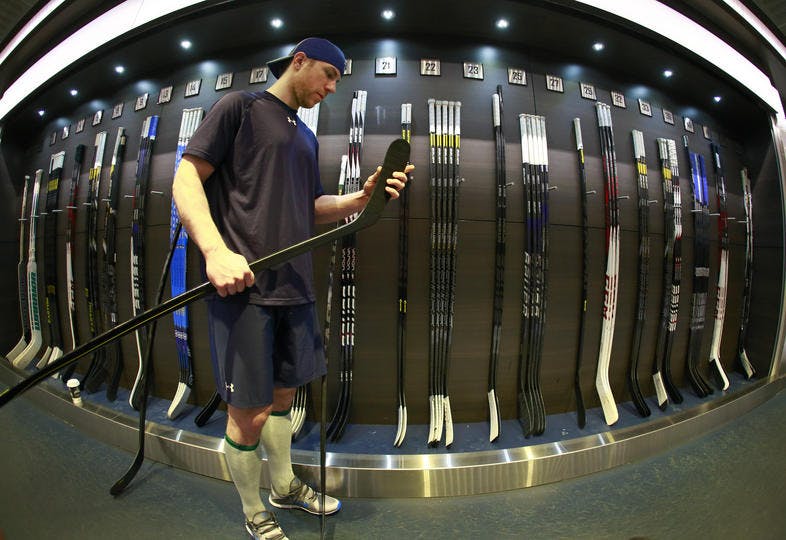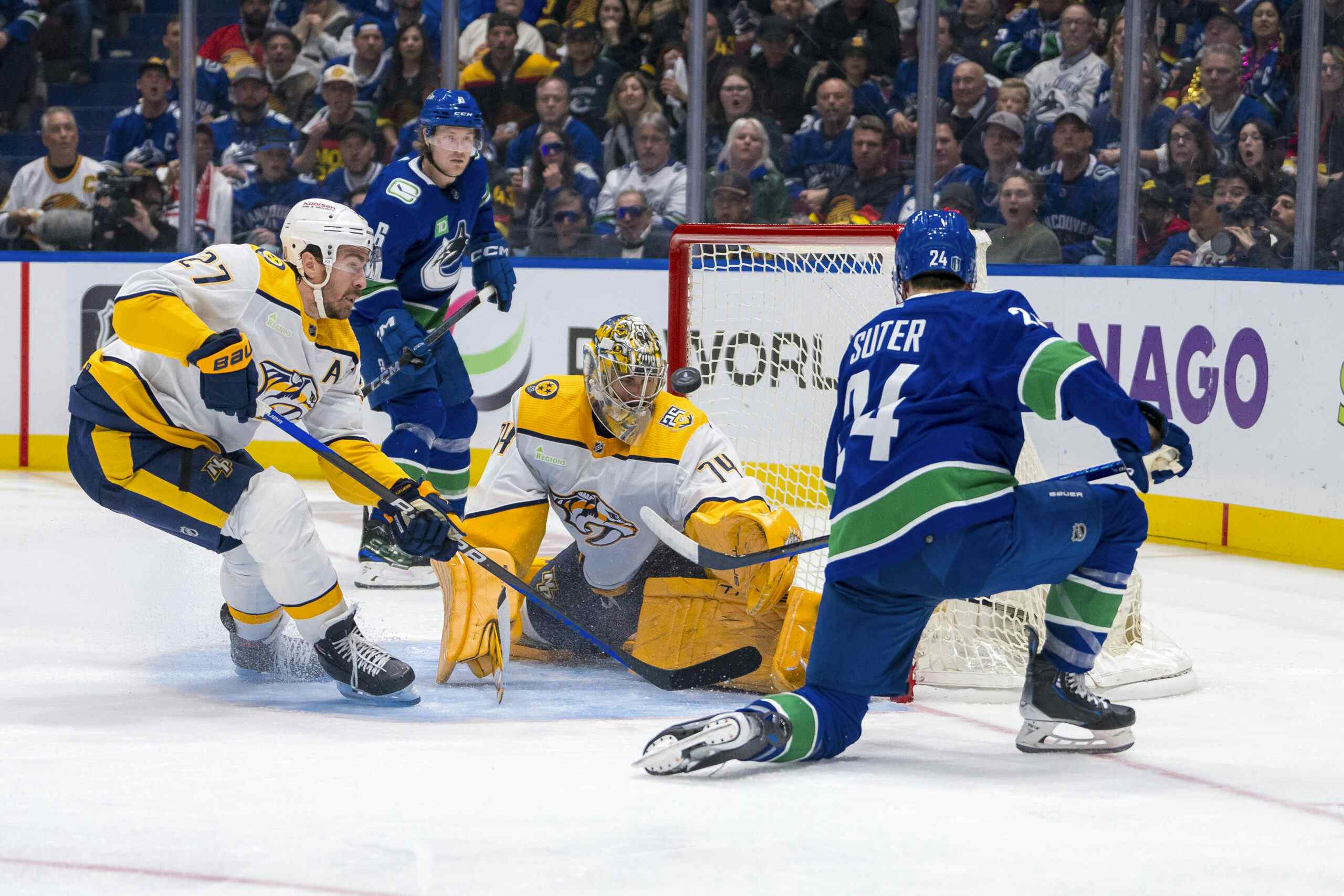Early Returns: Derek Roy’s First Week with the Canucks

Derek Roy selects his weapon of choice.
Photo Credit: Jeff Vinnick via NHLI
The day before the trade deadline Mike Gillis and the Canucks acquired centreman Derek Roy from the Dallas Stars. Though Gillis made more calls that day than Kobe will get in a first round matchup between the Lakers and Spurs later this month, it was his only meaningful move.
The lack of action disappointed some Canucks fans who empathized with Roberto Luongo and got ahead of themselves when Laurence Gilman went on the radio and told fans that the team was "all in." But as we wrote at the time, Mike Gillis managed to go out and get the one piece his team absolutely had to get – another NHL quality top-six centreman – and he did so at a relatively affordable rental price too.
So how is Derek Roy fitting in so far, and what changes has he wrought in the Canucks lineup? Let’s wade into some numbers on the other side of the jump.
40% – Through three games Derek Roy has started fifteen shifts in the defensive end of the ice, in comparison with ten shifts in the offensive end for a 40% o-zone start rate.
These are early returns shaped by miniscule samples, but from the looks of it, Derek Roy is playing a defensively oriented third-line role so far in Vancouver. In Roy’s first game as a Canuck he started only three shifts in the defensive end. In his second contest – a blowout win over Calgary – he started there seven times, but also recieved seven offensive zone starts. On Monday night, as Ryan Kesler returned to the lineup, Roy led the team in defensive zone starts with five and started only two shifts in the offensive end.
Again, we don’t have enough data to conclude anything really, but I think we can suggest that Roy’s defensive-type deployment is likely to become even more pronounced with Ryan Kesler’s return to the lineup.
8:12, 5:12, 8:30 – The amount of ice-time Derek Roy has spent in his first three games matched up against Ales Hemsky, Jiri Hudler and Shane Doan respectively (left to right).
While Derek Roy’s deployment patterns suggest a defensive orientation, he’s also taking on some relatively tough competition (obviously "tough competition" and "the Calgary Flames" are oxymorons at the moment, but put that aside and the point stands).
Late last week, Roy was the primary matchup for Ales Hemsky – who has bothered the Canucks significantly when they were icing one-line teams earlier in the season – and handed him his lunch. To wit, the Canucks recorded eleven shots with Roy on the ice in that contest and surrendered only one against.
The Calgary Flames are just awful, though, it’s kind of interesting to note that Alain Vigneault considers Mikael Backlund to be their number one centreman. You can tell because Backlund’s line saw the most ice-time against Dan Hamhuis and Jason Garrison…
Against Phoenix, and this is where this gets interesting, Derek Roy was matched up primarily with Shane Doan’s line, a line that also includes really good players Martin Hanzal and Radim Vrbata. Roy, HIggins and Hansen did a hell of job in a shutdown type role on Monday night, cleanly winning their matchup.
While I wouldn’t say that Roy’s line was "hard-matched" against Doan’s group on Monday night – Doan and Hanzal spent a good deal of minutes facing the Sedin line too – I would point out that by soaking up the most minutes against the toughest matchup, Roy’s presence allowed Alain Vigneault to get the Sedin twins on the ice for over eight minutes against Boyd Gordon and Rob Kilnkhammer (both of whom actually had a pretty good game). Meanwhile Ryan Kesler kicked in Antointe Vermette’s teeth..
All of this is a long and technical way of demonstrating that Derek Roy is handling some pretty difficult minutes for the Canucks so far.
71.4% – Vancouver’s Corsi% in score close situations with Derek Roy on the ice so far.
Corsi – for the skeptical and uninitiated – is just a tally of all shot attempts both for and against. It can be expressed as a +/- style number or as a ratio (as I’ve done here), but really it’s just used as a proxy for territorial play. The "score close" thing just means that we’re only looking at what hapened in a one goal game state.
Derek Roy has, as we’ve already established, faced difficult matchups and started most of his shifts in the defensive end of the rink in his first week as a Canucks centreman. Yet 71.4% of all shot attempts while Roy has been on the ice and while the game was in any doubt, have been directed at the net of Vancouver’s opponents.
This 71.4% number is obviously completely unsustainable. Still, so far the Canucks have completely dominated play with Derek Roy on the ice, as the diminutive centreman handles relatively difficult matchups at even-strength.
47.2%/55.5% – Chris Higgins’s Corsi For% expressed as a WOWY (with or without you) with Derek Roy. So Higgins has a 47.2 Corsi For percentage so far this season without Derek Roy, and a 55.5 Corsi For Percentage in his twenty some odd minutes with Roy since the trade.
Once again, we’re dealing with extremely small samples and we need to be careful not to say any definitive here. But in addressing the early returns of Roy’s impact, the fact that Chris Higgins’ underlying numbers have rebounded this past week is an auspicious marker.
As Dimitri pointed out a couple of weeks ago, Chris Higgins has seemed to really miss playing with quality line-mates for the majority of this season. When the Canucks extended Chris Higgins last week, I took into account his cratered underlying numbers while assessing the risk of a four year deal.
But perhaps all Chris Higgins really needed was a bit of additional support, preferably from a bonafide top-six NHL centreman. We’ll continue to watch this closely, but that’s looked like the case over the past week.
0 – The number of playoff teams the Canucks have defeated with Derek Roy in the lineup so far.
Derek Roy has seemed like an ideal fit over the past week, as the Canucks routed a handful of probable non-playoff teams by a combined score of 11-2. There’s really no doubt that Roy has made the Canucks an appreciably more dangerous team, but we’d be wise to wait for the rubber to really meet the road before we get ahead of ourselves.
That’s a necessary qualifier, but yeah, so far Derek Roy has been pretty damn good.
Data in this post collected from timeonice.com and stats.hockeyanalysis.com
Recent articles from Thomas Drance





